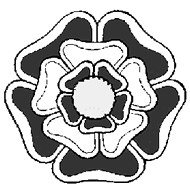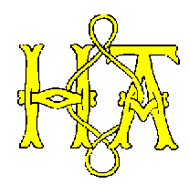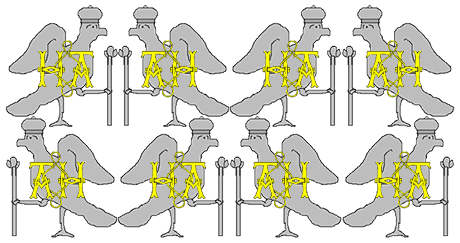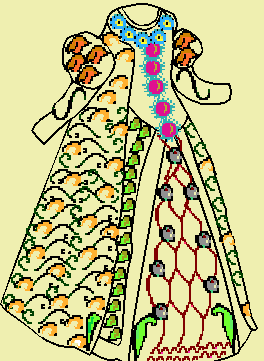Looking For Pattern
Look up, look down, look all around.
Margaret Still
This article first appeared in MAPE Focus on History Spring 2000
Looking for pattern lends itself to many cross curricular activities, and can
provide a starting point within many curriculum subjects
As an activity with children, looking for, discovering and examining patterns
can open up a whole area to be explored.
A wander around a building can reveal many patterns of design that are clues
to the age, period and style of the building itself and may provide an
indication of the inhabitants or previous inhabitants or other connections
people had with the building.
Look at the floors and ceilings, roofs, windows chimneys, stair rails.
Examine the ironwork. Look for heraldic symbols on the windows and stone work.
Are these patterns based on shapes or pictures?
Is there a basic shape to the overall design?
Are they repeating?
Do they tessellate?
Are they symmetrical?
You will find many monograms, crests and coats of arms embedded in the fabric
of many historic buildings.
Let the children: draw /collect pictures of the different signs, crests and
coats of arms.
 |
 |
 |
|
Tudor Rose
|
Anne Boleynís Badge
|
Henry and
Anneís Initials
|
Sort them in a variety of ways addressing certain criteria. Use this to
create a decision tree/branching database. Enter the information onto a computer
program Branch/Sorting game, Retreeval.
Through Information Technology children can explore and investigate patterns
and shapes. They can use art and drawing programs to recreate designs and
patterns they have seen. They may take a basic pattern and experiment with it;
creating, amending, and changing their designs, experimenting with size, shape
and colour and orientation.
Encourage children to:
look for and find patterns and examine their composition.
take one or two sketches of patterns they have seen that would be
appropriate to recreate or develop into a design on the computer.
use the sketch to design a basic tile and through the use of ICT arrange,
tessellate and organise the tile across the screen, creating perhaps a design
for fabric, wallpaper etc

Maybe they could design their own crests and badges for particular people,
thinking about their role in life, particular interests or where they were born.
What symbols on a crest would they give themselves? Why?
What about a new school badge?
Costume and Fabric Design
Costumes from the past are always a source of great interest to children
particularly if they are able to dress up. Many historic buildings or museums
that facilitate school parties give the opportunity for children to dress in
authentic clothes from a bygone age.
A Study of pattern design on clothes and fabric can give clues to the period
of the costume and will often relate to other designs and symbols seen in the
architecture and fabric of the building itself.
The wall hangings at the Queens house at Greenwich give an authentic feel to
the splendour of Jacobean fabrics. The museum allows children to examine and
feel examples of the cloth and to comment on warmth, weight, colour etc.
My World Files accompany this activity. They contain individual
designs copied from embroidery designs of the period. With them the children are
asked to :
|
i) design the pattern on a dress for Elizabeth 1
ii) place the embroidery on a glove for James 1
iii) design a wall hanging
To accompany their designs children can write
descriptions of the garments as
though they are for sale.
|

|
[top of page]

